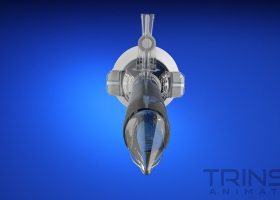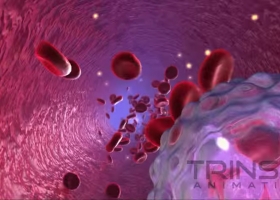Summary
The term "suspended animation" means to put life on hold. In the medical field, time is the critical and sometimes fatal factor: Time to reach treatment, get oxygen, to stop the bleeding, treat severe injuries, to save heart muscle and brain function. Suspended animation is the medical equivalent to a pause button. The process in which a patient is put into a state of suspension require the lowering of the body temperature to attain hypothermia and to replace the body's blood with a fluid called perfluorochemical. This animation describes the function of a portable device developed by Suspended Animation, Inc. and how the use of this liquid ventilation system may achieve both objectives at once. Using the patient's lungs as heat exchangers, this innovative medical device achieves the goals in a very short time period, making the treatment of patients more timely.
Transcription:
Suspended Animation, in conjunction with critical care research, presents the next generation in therapeutic hypothermia. The revolutionary portable liquid ventilation system. The fastest minimally invasive way, to cool cardiac arrest patients, in the hospital and in the field. Within minutes of cardiac arrest, the interruption of normal blood flow called ischemia, starves the brain and vital organs of oxygen and nutrients. There are number of medical techniques used to induce therapeutic levels of hypothermia. But none can be administered as simply and cool as effectively as the portable liquid ventilation system.
Packing a patient in ice or ice water, drops brain temperature a few degrees over several hours. If skilled medical professionals are available to catheterize or canulate a patient for cold bavaz or cardiac bypass. These procedure can take 35 minutes, to an hour to cool the brain by 3 degrees. But using the liquid ventilation system, first responders can produce this temperature drop in as little as 15 minutes, without an ice bath and without invasive procedures.
Why this liquid ventilation is so much fast and more effective?
Because it uses the patients own lungs as powerful heat exchangers. First an endotracheal tube is placed into the airway of the patient, with cardiac rhythm restored or supported mechanically. the liquid ventilation system’s delivery tube is connected and the system is activated. The system's computer then begins delivering carefully control cycles of ice cold liquid and oxygen in and out of the patients lungs. The liquid is a pleural carbon that does not damage the lungs. It supports both rapid heat exchange and gas exchange, as all of the body's blood pass through nearly 70 square meters of the lungs surface area. The ice cold pleural carbon removes heat and deliveries oxygen. Cooled blood from the lungs then circulates normally to the brain and the rest of the body cooling tissues as it travels.
Warm pleural carbon from the patients lungs cycles back to the liquid ventilation system. A heat exchangers submerged in ice water, cools it again before recycling to the patient. Sensors carefully monitor the patient's temperature and continue liquid ventilation cycling until the desired degree of protective hypothermia is achieved.



